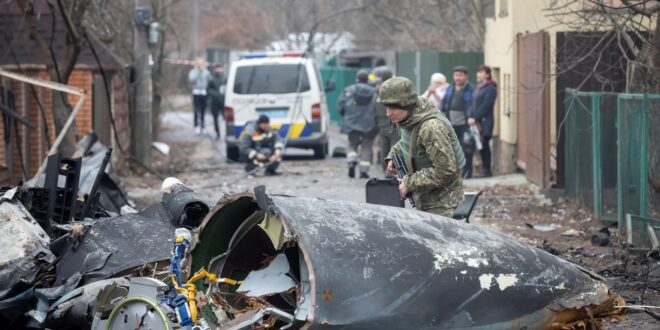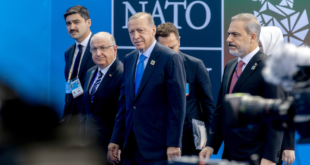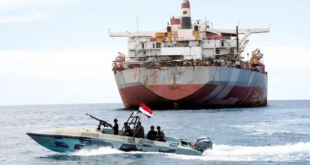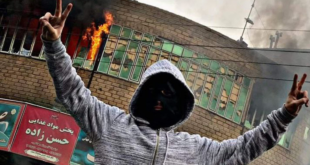The war is still in its infancy, but the Russian president’s claims that Ukraine is an artificial entity have been upended by Ukrainians fighting fiercely to save their homeland
The war between Russia and Ukraine may turn out to be a long and bitter affair between two countries with well-equipped armies, so it’s presumptuous to summarize after just three days of fighting. But one thing that can be said almost for certain is that Russian President Vladimir Putin had too much belief in his own propaganda.
It now seems his ahistoric claims that Ukraine is an artificial political entity and that its elected government is a “neo-Nazi junta” were also the basis for his military plans.
After the first stage of warfare, it is now clear that it won’t be enough to invade Ukraine on several fronts, bomb strategic as well as civilian targets, and land special forces at a few sites, including around Kyiv, to topple Ukraine’s state, its society and its army. They are all still standing firm.
Most of the Ukrainian population, even if they’re not too enthusiastic about their leadership, believe in their independent existence, separate from Russia, and are prepared to fight for their homeland. The pro-Russian elements that no doubt exist are not willing, or prepared, to join Putin at this stage either.
On the ground, Russian forces have made significant progress only in southern Ukraine, where they have invaded from the occupied Crimean Peninsula. From the east they have barely managed to advance out of the separatist enclaves in the Donbas (which served as Putin’s pretext for going to war) and the three fronts on which they’ve entered from the north, including from Russia’s protectorate Belarus, have achieved only limited success so far.
Russian attempts to take control of strategic points around Kyiv – such as the Hostomel airfield and a major power station – using helicopter-borne special forces have largely been repulsed. Russian air and missile attacks have yet to succeed in taking out Ukraine’s air defenses. Ukrainian fighter jets are still intercepting some Russian aircraft, while others are being shot down using surface-to-air missiles.
There is intense fighting in and around Kyiv, Kharkiv and Kherson, but from the reports so far, the Russians haven’t been able to concentrate sufficient forces to take any of Ukraine’s major cities.
It is much too early to reach any conclusions on what looks like an initial stutter for the Russian army. The cliché that no battle plan survives first contact with the enemy is almost always true. But Russia’s military is still superior, numerically and qualitatively, and only about half the units concentrated on Ukraine’s borders have so far been thrown into battle. Russia can bring much more, with time.
But what’s clear is that the blithe predictions of a Russian “blitzkrieg” rapidly overwhelming Ukraine were exaggerated to begin with.
Ukraine is the largest country in Europe after Russia, and even if the entire Russian army could be sent in, it would be insufficient to occupy all of it as long as significant Ukrainian resistance remains. And for now, the Ukrainians are bravely and resourcefully resisting, and can be expected to continue doing so.
The talk of Kyiv’s vulnerability was also greatly exaggerated. This is a city of nearly 3 million residents. It is not Syria’s Aleppo or Chechnya’s Grozny, which Russian bombs and missiles could just pound into dust. Putin regards Kyiv as a historic Russian city, as do many Russian citizens who have visited and have friends and family there. The Russian plan was to topple the government in Kyiv through small special forces incursions. So far, that isn’t working.
Russia’s failure to achieve air superiority in the initial stage of fighting also demonstrates the limits of the modernization of its armed forces. In recent years, Russia’s air force has mainly experience of bombing Syrian civilians in enclaves held by rebels with very limited anti-aircraft capabilities.
Ukraine’s air defense systems are not the most advanced, but they still have a relatively large number of them. Effective suppression of enemy air defenses (SEAD) calls for accurate intelligence, guided munitions and pilots who have been trained specifically for these missions. It seems the Russian air force has yet to reach that level.
A lack of air superiority has also made it much more difficult for Russia to capture and hold key locations within Ukraine, which would then be used as logistical hubs to replenish their advancing ground forces. Ukrainian social media accounts are filled with footage of Russian tanks and armored vehicles that are stuck on the road without gas.
Every ground war is a logistical nightmare, and the Russians at this stage haven’t found a solution for supplying their large armored columns still waiting to invade.
The Russians can be expected to somehow solve their operational and logistical issues if the war drags on. But it has already delayed their plans and highlighted a much bigger problem that won’t disappear with time.
From videos of Russian soldiers captured by the Ukrainians, it seems they are muddled and haven’t been given full information on what they are doing. They talk of being on an “exercise” or limited “operation” – not an invasion and all-out war. We must never base reports or analysis on the accounts of POWs who could be coerced. However, in this case it tallies with the orders given to Russian media by the official Kremlin watchdog, which forbade them from using the words “war,” “invasion” and “attack” in their reporting.
As far as the official Russian version goes, this is still just a “special operation” focusing on preventing a “genocide” in the Donbas region.
The Russian public isn’t stupid and has other means of getting information, as the Kremlin’s current attempts to block local social media show.
But it’s not just a propaganda issue. It seems Russian soldiers aren’t hugely enthused at the prospect of fighting in a sister country where the people speak their language and look just like them and their family members. This contributes to a massive morale gap between them and the Ukrainian soldiers defending their homeland.
Another factor that has sapped Russian fighting morale has been the long weeks and months spent in makeshift staging areas on the border, where reports say entire Russian units have been ravaged by waves of COVID-19. It has been difficult to feed them properly and provide medical treatment, even before they invaded last week.
It’s easy to succumb to wishful thinking over these initial setbacks for the Russian army, which has yet to move its large armored divisions into Ukraine. These will be much more difficult to stop in their tracks, but the initial problems indicate that the unwieldy formations will have trouble, strung out on narrow roads. This will allow highly mobile Ukrainian teams to pick them off with anti-tank weapons – whether using old Soviet-made RPGs or the more advanced Western missiles, of which thousands have been supplied to Ukraine in recent weeks and are continuing to arrive.
Russia’s Defense Ministry currently maintains that it has suffered no casualties in the war, though the numbers are at least in their hundreds. They will continue to mount.
Russia is much larger and stronger than Ukraine, but if Putin believed that a war would quickly prove that Ukraine is a hollow and fake nation, he has already failed at that. Even if his forces succeed in assassinating President Volodymyr Zelenskyy and installing a puppet regime in Kyiv, total military and political victory may be beyond his grasp.
 Eurasia Press & News
Eurasia Press & News




